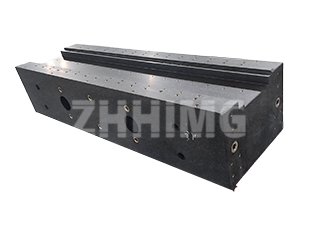The precision granite inspection platform is the undisputed cornerstone of modern metrology, providing the stable, accurate reference plane necessary for verifying nanoscale and sub-micron tolerances. Yet, even the finest granite tool—such as those produced by ZHHIMG—is susceptible to environmental factors that can momentarily compromise its accuracy. For any engineer or quality control professional, understanding these influencing factors and adhering to rigorous usage protocols is crucial to maintaining the platform’s integrity.
The Dominant Factor: Thermal Influence on Metrology
The single most significant threat to the accuracy of a granite inspection platform is temperature variation. While materials like our high-density ZHHIMG® Black Granite possess superior thermal stability compared to metals and even common marbles, they are not immune to heat. Direct sunlight, proximity to heat sources (such as electric furnaces or heating ducts), and even placement against a warm wall can cause thermal gradients across the granite block. This leads to subtle but measurable thermal deformation, instantaneously degrading the platform’s certified flatness and geometry.
The cardinal rule of metrology is consistency: measurement must occur at the standard reference temperature, which is 20℃ (≈ 68°F). Practically, maintaining a perfectly constant ambient temperature is the ideal, but the most critical consideration is ensuring that the workpiece and the granite gauge are thermally stabilized at the same temperature. Metallic workpieces are particularly sensitive to thermal expansion and contraction, meaning a component taken directly from a warmer workshop area will yield an inaccurate reading when placed on a colder granite platform. The meticulous user allows ample time for thermal soaking—letting both the workpiece and the gauge equilibrate to the ambient temperature of the inspection area—to ensure reliable data.
Preserving Precision: Essential Usage and Handling Protocols
To harness the full potential and certified accuracy of a precision granite platform, strict attention must be paid to its handling and interaction with other tools and workpieces.
Prior Preparation and Verification
All inspection work begins with cleanliness. Before any measurement takes place, the granite reference workbench, the granite square, and all contact measuring tools must be meticulously cleaned and verified. Contaminants—even microscopic dust particles—can act as high spots, introducing errors greater than the tolerance being measured. This foundational cleaning is the non-negotiable prerequisite for high-precision work.
Gentle Interaction: The Rule of Non-Abrasive Contact
When placing the granite component, such as a 90° triangular square, onto the reference surface plate, the user must place it slowly and gently. Excessive force can induce stress fractures or micro-chipping, permanently damaging the highly precise 90° working surfaces and rendering the tool unusable.
Furthermore, during the actual inspection process—for instance, when checking the straightness or perpendicularity of a workpiece—the granite inspection tool should never be slid or rubbed back and forth against the reference surface. Even a small amount of abrasion between two precision-lapped surfaces will cause minute, irreversible wear, incrementally altering the calibrated precision of both the square and the surface plate. To facilitate handling without compromising the working faces, specialized granite components often feature design details, such as the circular weight-reducing holes on the non-working surface of a square, which allow the user to grip the hypotenuse directly while avoiding the critical right-angled working surfaces.
Maintaining a Clean Interface
The workpiece itself demands attention. It must be wiped clean before inspection to avoid transferring excessive oil or debris to the granite surface. If oil or coolant residue does transfer, it must be promptly wiped off the platform after the inspection is complete. Allowing residues to accumulate can create surface film irregularities that degrade measurement accuracy and make subsequent cleaning more difficult. Finally, precision granite tools, especially smaller components, are designed for accurate reference, not physical manipulation. They should never be used directly to strike or impact other objects.
By diligently managing the thermal environment and adhering to these critical handling and cleanliness protocols, professionals can ensure their ZHHIMG Precision Granite Inspection Platform consistently delivers the certified, nanoscale accuracy required by the world’s most demanding industries.
Post time: Nov-03-2025

